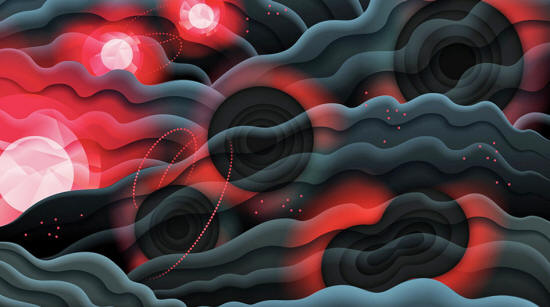|
from QuantaMagazine Website
for
Quanta Magazine
gravitational waves coming from the mergers of black holes
are shaking up astrophysics.
"They," as everybody knew, were the two massive black holes that, more than 1 billion years ago and in a remote corner of the cosmos, spiraled together and merged, making waves in the fabric of space and time.
These "gravitational waves" rippled outward and, on Sept. 14, 2015, swept past Earth, strumming the ultrasensitive detectors of the Laser Interferometer Gravitational-Wave Observatory (LIGO).
LIGO's discovery, announced in February, triumphantly vindicated Albert Einstein's 1916 prediction that gravitational waves exist.
By tuning in to these tiny tremors in space-time and revealing for the first time the invisible activity of black holes - objects so dense that not even light can escape their gravitational pull - LIGO promised to open a new window on the universe, akin, some said, to when Galileo first pointed a telescope at the sky.
Already, the new gravitational-wave data has shaken up the field of astrophysics. In response, three dozen experts spent two weeks in August sorting through the implications at the Kavli Institute for Theoretical Physics (KITP) in Santa Barbara.
Jump-starting the discussions, de Mink, an assistant professor of astrophysics at the University of Amsterdam, explained that of the two - and possibly more - black-hole mergers that LIGO has detected so far, the first and mightiest event, labeled GW150914, presented the biggest puzzle.
LIGO was expected to spot pairs of black holes weighing in the neighborhood of 10 times the mass of the sun, but these packed roughly 30 solar masses apiece.
The mystery, she explained, is twofold:
A pair of stars that are born huge and close together will normally mingle and then merge before ever collapsing into black holes, failing to kick up detectable gravitational waves.
Selma de Mink of the University of Amsterdam has devised a new theory stating that pairs of black holes close enough to merge come from massive stars whose contents have been mixed until they are homogeneous throughout. E. Buunk
Nailing down the story behind GW150914,
Experts must retrace the uncertain steps from the moment of the merger back through the death, life and birth of a pair of stars - a sequence that involves much unresolved astrophysics.
Understanding LIGO's data will demand a reckoning of,
... and more.
The work has just begun, but already LIGO's first few detections have pushed two theories of binary black-hole formation to the front of the pack.
Over the two weeks in Santa Barbara, a rivalry heated up between the new "chemically homogeneous" model for the formation of black-hole binaries, proposed by de Mink and colleagues earlier this year, and the classic "common envelope" model espoused by many other experts.
Both theories (and a cluster of competitors) might be true somewhere in the cosmos, but probably only one of them accounts for the vast majority of black-hole mergers.
Star Stories
NASA, ESA, F. Paresce, R. O'Connell and the Wide Field Camera 3 Science Oversight Committee The R136 star cluster at the heart of the Tarantula Nebula gives rise to many massive stars, which are thought to be the progenitors of black-hole binaries.
The story of GW150914 almost certainly starts with massive stars - those that are at least eight times as heavy as the sun and which, though rare, play a starring role in galaxies.
Massive stars are the ones that explode as supernovas, spewing matter into space to be recycled as new stars; only their cores then collapse into black holes and neutron stars, which drive exotic and influential phenomena such as gamma-ray bursts, pulsars and X-ray binaries.
De Mink and collaborators showed in 2012 (Binary Interaction Dominates the Evolution of Massive Stars) that most known massive stars live in binary systems. Binary massive stars, in her telling, "dance" and "kiss" and suck each other's hydrogen fuel "like vampires," depending on the circumstances.
But which circumstances lead them to shrink down to points that recede behind veils of darkness, and then collide?
The conventional common-envelope story, developed over decades starting with the 1970s work of the Soviet scientists Aleksandr Tutukov and Lev Yungelson, tells of a pair of massive stars that are born in a wide orbit.
As the first star runs out of fuel in its core, its outer layers of hydrogen puff up, forming a "red supergiant."
Much of this hydrogen gas gets sucked away by the second star, vampire-style, and the core of the first star eventually collapses into a black hole. The interaction draws the pair closer, so that when the second star puffs up into a supergiant, it engulfs the two of them in a common envelope.
The companions sink ever closer as they wade through the hydrogen gas. Eventually, the envelope is lost to space, and the core of the second star, like the first, collapses into a black hole.
The two black holes are close enough to someday merge.
Because the stars shed so much mass, this model is expected to yield pairs of black holes on the lighter side, weighing in the ballpark of 10 solar masses. LIGO's second signal, from the merger of eight- and 14-solar-mass black holes, is a home run for the model.
But some experts say that the first event, GW150914, is a stretch.
In a June paper in Nature (The First Gravitational-Wave Source from the Isolated Evolution of Two Stars in the 40-100 Solar Mass Range), Daniel Holz and collaborators Krzysztof Belczynski, Tomasz Bulik and Richard O'Shaughnessy argued that common envelopes can theoretically produce mergers of 30-solar-mass black holes if the progenitor stars weigh something like 90 solar masses and contain almost no metal (which accelerates mass loss).
Such heavy binary systems are likely to be relatively rare in the universe, raising doubts in some minds about whether LIGO would have observed such an outlier so soon.
In Santa Barbara, scientists agreed that if LIGO detects many very heavy mergers relative to lighter ones, this will weaken the case for the common-envelope scenario.
Lucy Reading-Ikkanda for Quanta Magazine
This weakness of the conventional theory has created an opening for new ideas.
One such idea began brewing in 2014, when de Mink and Ilya Mandel, an astrophysicist at the University of Birmingham and a member of the LIGO collaboration, realized that a type of binary-star system that de Mink has studied for years might be just the ticket to forming massive binary black holes.
The chemically homogeneous model begins with a pair of massive stars that are rotating around each other extremely rapidly and so close together that they become "tidally locked," like tango dancers.
In tango,
This spinning stirs the stars, making them hot and homogeneous throughout.
And this process might allow the stars to undergo fusion throughout their whole interiors, rather than just their cores, until both stars use up all their fuel. Because the stars never expand, they do not intermingle or shed mass. Instead, each collapses wholesale under its own weight into a massive black hole.
The black holes dance for a few billion years, gradually spiraling closer and closer until, in a space-time-buckling split second, they coalesce. De Mink and Mandel made their case for the chemically homogeneous model in a paper (The Chemically Homogeneous Evolutionary Channel for Binary Black Hole Mergers - Rates and Properties of Gravitational-Wave Events Detectable by Advanced LIGO) posted online in January.
Another paper (A New Route towards Merging Massive Black Holes) proposing the same idea, by researchers at the University of Bonn led by the graduate student Pablo Marchant, appeared days later.
When LIGO announced the detection of GW150914 the following month, the chemically homogeneous theory shot to prominence.
However, aside from some provisional evidence, the existence of stirred stars is speculative.
And some experts question the model's efficacy. Simulations suggest that the chemically homogeneous model struggles to explain smaller black-hole binaries like those in LIGO's second signal.
Worse, doubt has arisen as to how well the theory really accounts for GW150914, which is supposed to be its main success story.
All Spun Up
Along with the masses of the colliding black holes, LIGO's gravitational-wave signals also reveal whether the black holes were spinning.
At first, researchers paid less attention to the spin measurement, in part because gravitational waves only register spin if black holes are spinning around the same axis that they orbit each other around, saying nothing about spin in other directions.
However, in a May paper (GW150914 - Spin Based Constraints on the Merger Time of the Progenitor System), researchers at the Institute for Advanced Study in Princeton, N.J., and the Hebrew University of Jerusalem argued that the kind of spin that LIGO measures is exactly the kind black holes would be expected to have if they formed via the chemically homogeneous channel. (Tango dancers spin and orbit each other in the same direction.)
And yet, the 30-solar-mass black holes in GW150914 were measured to have very low spin, if any, seemingly striking a blow against the tango scenario.
Daniel Holz of the University of Chicago works on the classic common-envelope explanation for the formation of black-hole binaries. Courtesy of Daniel Holz
After some debate, the scientists agreed that the answer was yes.
However, mere days later, de Mink, Marchant, and Cantiello found a possible way out for the theory.
Cantiello, who has recently made strides in studying stellar magnetic fields, realized that the tangoing stars in the chemically homogeneous channel are essentially spinning balls of charge that would have powerful magnetic fields, and these magnetic fields are likely to cause the star's outer layers to stream into strong poles.
In the same way that a spinning figure skater slows down when she extends her arms, these poles would act like brakes, gradually reducing the stars' spin. The trio has since been working to see if their simulations bear out this picture.
Quataert called the idea,
Lucy Reading-Ikkanda for Quanta Magazine Source: LIGO
On the last day of the program, setting the stage for an eventful autumn as LIGO comes back online with higher sensitivity and more gravitational-wave signals roll in, the scientists signed "Phinney's Declaration," a list of concrete statements about what their various theories predict.
As the data pile up, an underdog theory of black-hole binary formation could conceivably gain traction - for instance, the notion that binaries form through dynamical interactions inside dense star-forming regions called "globular clusters."
LIGO's first run suggested that black-hole mergers are more common than the globular-cluster model predicts. But perhaps the experiment just got lucky last time and the estimated merger rate will drop.
Adding to the mix, a group of cosmologists recently theorized that GW150914 might have come from the merger of primordial black holes, which were never stars to begin with but rather formed shortly after the Big Bang from the collapse of energetic patches of space-time.
Intriguingly, the researchers argued in a recent paper in Physical Review Letters (Did LIGO Detect Dark Matter?) that such 30-solar-mass primordial black holes could comprise some or all of the missing "dark matter" that pervades the cosmos.
There's a way of testing the idea against astrophysical signals called fast radio bursts.
It's perhaps too soon to dwell on such an enticing possibility; astrophysicists point out that it would require suspiciously good luck for black holes from the Big Bang to happen to merge at just the right time for us to detect them, 13.8 billion years later.
This is another example of the new logic that researchers must confront at the dawn of gravitational-wave astronomy.
|







